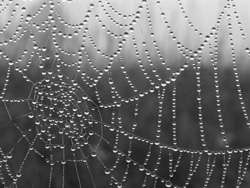Credit: Thinkstock
Researchers have delved into the dynamics of vapour condensation on surfaces. Project outcomes have potential commercial applications to a variety of fields.
Dew, created by the condensation of water molecules on a surface (substrate) to form droplets, is nothing new. However, in the laboratory dew has taken on new significance in the form of ‘breath figures’, or the complex patterns of condensed vapour on cold substrates.
Although this phenomenon has been studied for some time, many questions remain concerning interactions between substrates and condensing compounds (condensates) in specific environments and the dynamical growth of breath figures and the resulting patterns.
Among the various parameters of interest are condensate-substrate contact angle and the hydrophobic (water ‘fearing’ or repelling) or hydrophilic (water ‘loving’ or attracting) nature of the substrate for the case of water condensation, in particular in relation to self-cleaning behaviour.
Researchers sought to evaluate the dynamics of breath figure formation with EU-funding for the ‘Dynamics and control of breath figures’ (DAC OF BREF) project.
During the reporting period covered herein, scientists focused on two cases related to the parameters of interest: first, the study of breath figures on super-hydrophobic surfaces and, second, investigating the spatial dependence of breath figures forming on heterogeneous (mixed hydrophilic and hydrophobic) substrates.
DAC OF BREF researchers conducted experimental and computational analyses of the dynamics of breath figure formation on a substrate having contact angle ranging from 0 degrees to more than 150 degrees. The results were presented in a peer reviewed publication. In addition, results from studies of breath figure growth dynamics on substrates with small hydrophilic areas surrounded by large hydrophobic ones were presented at international scientific conferences.
The coalescing drops of water can be seen to jump on a solid substrate (cyclohexane) near its melting point. DAC OF BREF researchers studied the kinetics of jumping water drops to evaluate its relation to growth dynamics.
Continuing research promises enhanced understanding of breath figure formation with potential applications to a variety of fields including thin film growth and atmospheric water recovery in addition to self-cleaning surfaces.
Provided by CORDIS






















